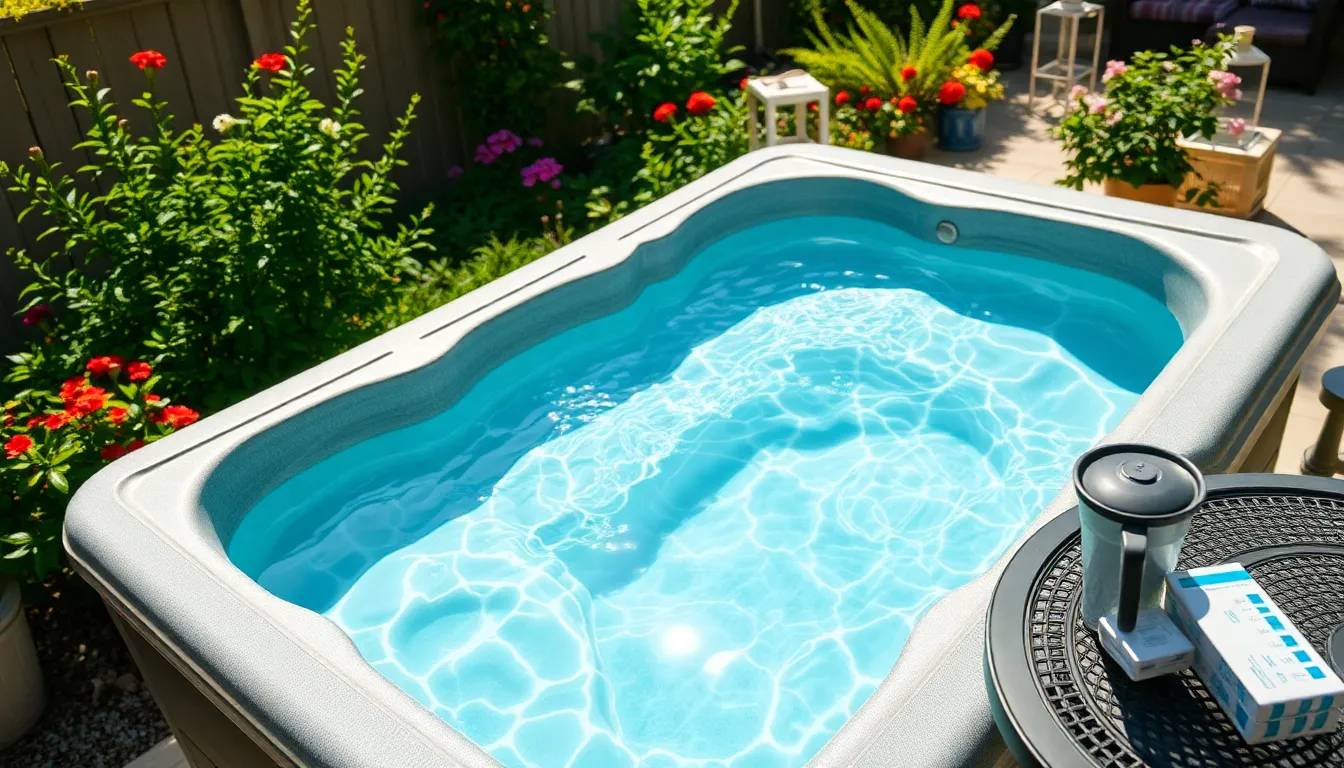Table of Contents
ToggleHot tubs are the ultimate relaxation oasis, offering a bubbling retreat from the chaos of everyday life. But before diving into that warm water, it’s crucial to keep the hot tub in tip-top shape. After all, nobody wants to soak in a science experiment gone wrong! Regular maintenance not only ensures a sparkling clean tub but also extends its lifespan, saving you from costly repairs down the line.
What Is Hot Tub Maintenance?
Hot tub maintenance involves regular tasks designed to keep the hot tub in optimal condition. This process includes checking water chemistry, cleaning filters, and inspecting components. Regular maintenance prevents buildup of contaminants, which can compromise water quality.
Water chemistry plays a crucial role in maintaining a hot tub. pH levels must remain between 7.2 and 7.8 for effective sanitation. Alkalinity and calcium hardness levels also need monitoring to avoid corrosion or scale buildup. This ensures a safe and comfortable environment for users.
Cleaning the filters should occur every one to three months, depending on usage. The buildup of debris can restrict water flow and strain the pump. Replacing the filters every 12 to 24 months helps optimal water circulation and reduces maintenance efforts.
Inspecting other components, such as pumps and heaters, represents another key aspect of maintenance. Noticing unusual sounds or leaks early can help prevent more significant issues. It’s advisable to routinely check the hot tub cover for tears or damage, as a well-maintained cover enhances energy efficiency.
Keeping the hot tub clean enhances the overall experience. Regularly draining and refilling the hot tub every three to four months helps remove accumulated contaminants. Wiping down surfaces and cleaning the interior also contributes to a pleasant ambiance.
Adhering to these maintenance practices not only guarantees clean water but also promotes longevity for the hot tub. Proper care reduces the need for repairs and enhances the overall enjoyment of the hot tub experience.
Importance Of Regular Maintenance

Regular maintenance plays a vital role in hot tub ownership. It ensures clean water and enhances user experience.
Health Benefits
Maintaining water quality reduces the risk of skin irritations and infections. Regularly balanced water chemistry protects users from harmful bacteria and algae. Routine cleaning prevents the buildup of contaminants, promoting a healthier spa environment. Comfortable water temperatures and proper filtration support relaxation and stress relief. Improved hygiene contributes to overall wellbeing, making a hot tub a safe retreat.
Cost Savings
Regular maintenance significantly lowers long-term operational costs. Proper upkeep prevents expensive repairs from neglected components. Maintaining clean filters enhances water circulation, reducing energy consumption. Frequent checks on pumps and heaters avert costly breakdowns and extend equipment life. Investing time in maintenance ultimately leads to better financial stability, ensuring the hot tub remains an enjoyable asset through consistent use.
Essential Maintenance Tasks
Hot tub maintenance involves key tasks that keep the water clean and the system operating efficiently. Regular upkeep enhances the enjoyment and lifespan of the hot tub.
Water Testing And Balancing
Testing water chemistry remains crucial. The ideal pH level should stay between 7.2 and 7.8, while both alkalinity and calcium hardness require monitoring. Imbalances can cause damage, impacting both the hot tub and the individuals using it. Use test strips or kits weekly to check these levels and adjust with necessary chemicals. Keeping chlorine or bromine within the recommended range ensures effective sanitation, which helps reduce skin irritations and maintains a comfortable bathing experience.
Cleaning The Filters
Filter cleaning ensures optimal water circulation. Typically, filters require cleaning every one to three months, depending on usage. Rinsing them with a hose removes debris and contaminants. Every 12 to 24 months, replacing filters is essential to maintain efficiency. Clean, properly functioning filters prevent clogs and enhance water quality, contributing to a pleasant hot tub environment.
Draining And Refilling
Draining and refilling the hot tub every three to four months is vital. This practice refreshes the water and removes accumulated contaminants. Thoroughly clean surfaces and interiors during the process, ensuring no buildup remains. Flushing the plumbing lines can also benefit overall hygiene. This regular activity not only improves water quality but also enhances the hot tub’s longevity, making each soak more enjoyable.
Common Hot Tub Issues
Hot tub owners may encounter several common issues that affect performance and enjoyment. Identifying and addressing these problems promptly ensures a better experience.
Algae Growth
Algae growth occurs when water conditions favor bacteria and algae. A lack of proper sanitization leads to green or slimy surfaces. Maintaining chlorine levels between 1 and 3 parts per million helps inhibit growth. Regular use of algaecide can provide additional protection. Cleaning the hot tub regularly, particularly in hard-to-reach areas, minimizes exposure to sunlight and contaminants. Ensuring proper water circulation through operational filters also contributes to algae prevention.
Cloudy Water
Cloudy water signals potential problems with filtration or chemicals. Inadequate sanitizer levels often cause this issue, making it essential to test water regularly. Adjusting pH levels between 7.2 and 7.8 ensures clarity. Additionally, cleaning the filter and replacing it if necessary promotes clear water. Avoiding excessive use of lotions or oils before entering the hot tub helps prevent cloudiness. Regularly draining and refilling the hot tub every three to four months refreshes the water, ensuring a pleasant soak.
Equipment Failures
Equipment failures can disrupt hot tub enjoyment significantly. Common issues include malfunctioning heaters or pumps, often indicated by unusual noises or inconsistent temperatures. Regular inspections of components help detect problems early. Maintaining clean filters prevents strain on the pump, promoting longevity. Scheduling professional servicing every year addresses issues proactively. Users should also monitor electric connections for signs of wear. Staying alert to these indicators fosters a reliable hot tub experience.
Tips For Efficient Maintenance
Regular maintenance significantly impacts the longevity and enjoyment of a hot tub. Following a structured approach simplifies the upkeep process.
Creating A Maintenance Schedule
Establishing a consistent maintenance schedule keeps hot tubs in optimal condition. Schedule weekly, monthly, and quarterly tasks to ensure thorough upkeep. Weekly, test water chemistry, adjusting pH levels between 7.2 and 7.8. Monthly, clean filters and inspect components for sounds or leaks. Every three to four months, drain and refill the hot tub, removing buildup and contaminants. Mark specific dates on a calendar to track these tasks easily. Sticking to a routine not only enhances water quality but also helps identify potential issues early.
Using The Right Products
Utilizing the right products significantly affects hot tub maintenance success. Choose sanitizers like chlorine or bromine to maintain clean water, ensuring levels stay between 1 and 3 parts per million. Select high-quality pH balancers to address alkalinity and calcium hardness effectively. Products designed for hot tub cleaning, such as surface cleaners and filter treatments, improve overall performance. Stick to manufacturer-recommended products to avoid damaging the equipment or surfaces. Investing in suitable maintenance essentials preserves water quality and extends the lifespan of the hot tub, promoting an enjoyable experience.
Maintaining a hot tub is essential for maximizing enjoyment and ensuring a safe environment. Regular upkeep not only keeps the water clean but also prolongs the lifespan of the equipment. By sticking to a structured maintenance schedule and using the right products, hot tub owners can prevent common issues and reduce long-term costs.
Investing time in maintenance leads to a more relaxing experience while promoting overall wellbeing. With proper care, a hot tub can remain a cherished retreat for years to come, offering both comfort and health benefits. Embracing these practices ensures that every soak is as refreshing and enjoyable as it should be.




